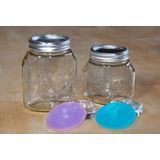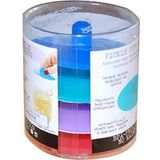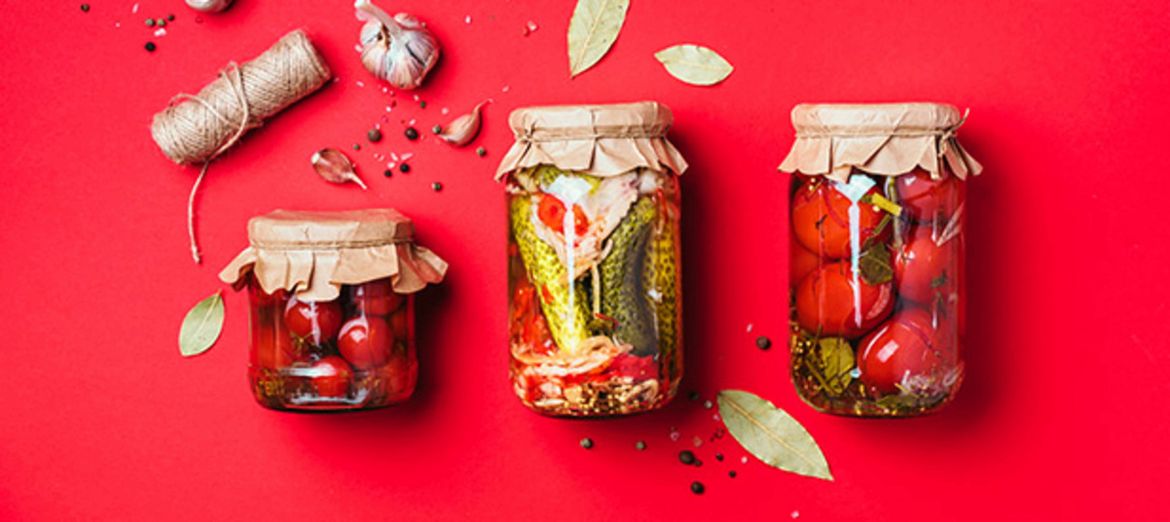Wet Fermentation
For easy and safe wet fermentation, we recommend the MASON fermentation kit by Khoysan.
Wet fermentation involves fermenting with the help of brine. This type of fermentation is suitable for larger pieces of vegetables such as larger pieces of cauliflower, carrots, pumpkin, broccoli ... or whole vegetables such as cocktail tomatoes, shallots, garlic cloves or gherkins.
Wet fermentation with brine
Start out by making the brine. As a rule, 2% brine is used in fermentation, i.e. 20 g salt per 1 litre of water. Simply stir the salt into cold water until it has completely dissolved. Note: in the case of very watery vegetables such as cucumbers, zucchini or tomatoes, a 3.5% brine (35 g salt in 1 litre of water) must be used.
- Wash the vegetables and chop them into bite-sized pieces depending on the type of vegetable or your preference.
- Add any spices that you would like to use.
- Then layer everything tightly in the glass jar and press down firmly with a tamper to get rid of air bubbles.
- Weigh everything down with a weight and pour the brine over it until everything is well covered with liquid. No pieces of vegetables should float on top or be visible above the brine.
- Place the fermentation attachment on the glass jar and screw it on with the screw ring.
- Let it ferment at room temperature. Summer vegetables / soft vegetables should be tasted after about five days, harder vegetables after about ten to fourteen days. If the taste or acidity is right, remove the glass weight and replace the fermentation attachment with a solid lid. Store in a cool place (cold room in the cellar or refrigerator).
Recipes
Carrots with ginger
Ingredients for approx. two jars (1 l)
- 1 kg of carrots
- 1 clove of garlic
- 5 cm of ginger about 1 cm thick
- 2% brine
- Optional: 1 small fresh chilli pepper whole or ¼ teaspoon chilli flakes
Method:
Wash the carrots and cut into sticks, cut the ginger into thin slices, peel the garlic and place in the glass with the chilli flakes / fresh chilli rings.
Layer the carrots and ginger tightly in the glass (up to the neck of the glass) and then pour the brine over them.
For further steps see above. (Let it ferment for approx. 14 days at room temperature.)
Shallots
Ingredients for approx. 1 jar (0.7 l)
- ¼ kg shallots
- 1–2 bay leaves
- 1 teaspoon peppercorns
- 2% brine
Method:
Peel the shallots. Add the bay leaves and pepper to the jar first, layer the shallots on top.
Pour brine to cover entirely.
Further steps as described above. (Let it ferment for about 10 days at room temperature and then refrigerate.)
Mixed vegetables
Ingredients for approx. 2 jars (0.7 l)
- 1 cauliflower, small
- 1 red pepper
- 2 large carrots
- 2 stalks of celery
- a handful of shallots or a couple of small onions
- 4 cloves of garlic
- 2 bay leaves
- 1 teaspoon peppercorns
- 2% brine
- Optional: 1 small fresh chilli pepper whole or ¼ teaspoon chilli flakes
Method:
Wash vegetables and cut into bite-sized pieces.
First place bay leaves and peppercorns into the jar and then layer and mash the vegetables tightly on top.
Fill up with brine, weigh down with the glass weight and make sure that everything is completely covered with the brine.
For further steps see above. (Let stand as dark as possible at room temperature for ten to fourteen days - then taste and see.)
Cocktail tomatoes with basil
Ingredients for approx. 1 jar (1 l)
- ½ kg of cocktail tomatoes
- 1 handful of basil leaves
- ½ onion, cut into rings
- 3.5% brine
- Optional: a few sprigs of thyme
Method:
Place the onion rings and basil leaves in the jar first. Wash the tomatoes and pierce each tomato three to four times with a toothpick and layer them tightly in the glass.
Weigh down everything with a glass weight and pour brine over it.
For further steps see above. (Let it ferment for approx. 5 days - at higher temperatures - such as in summer - 3 days can be enough - then give it a try.)
Related products
-
 4.5 (2)
4.5 (2)Khoysan Meersalz Complete Fermentation Kit
- Several practical fermentation accessories in one set
- BPA and phthalate-free
- A sustainable method of preservation
€ 74,49Delivery by April 17
-
 5.0 (2)
5.0 (2)Khoysan Meersalz Complete Set of Fermenting Glasses, 1 Litre
- With a 2-part screw cap
- Available in two different sizes
- Glass weight + silicone airlock
€ 25,49Delivery by April 17
-
 5.0 (1)
5.0 (1)Khoysan Meersalz 4 Pc Set of Silicone Airlocks
- BPA and phthalate-free
- 1 set with 4 airlocks
- With one-way valve
€ 29,99Delivery by April 17
Magazine Articles:
Discover Piccantino :
-
Austria: Free standard delivery from € 49,90
-
Free
returns -
24-hour shipping
More than 11.500 products

